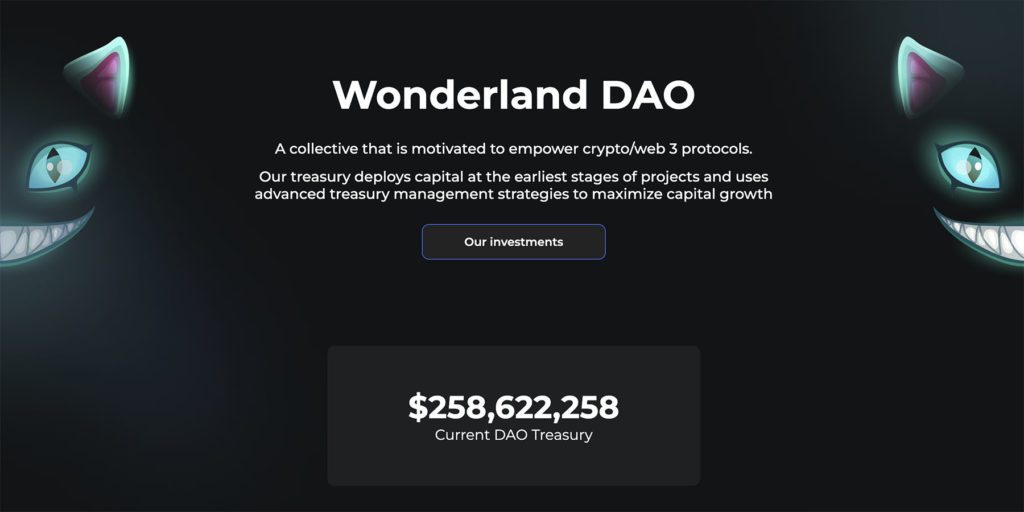OHM forks are projects inspired by the Olympus DAO. These copies of the OHM codebase are among the biggest catalysts toward Defi 2.0. The intent of using an OHM fork is to obtain the liquidity of a protocol as opposed to relying on yield farming. As a result of its success, Olympus DAO has been the focal point of many offshoots and projects.
Here are some of the top OHM forks you’ll come across in the blockchain market.
Wonderland (TIME)
If you’re familiar with OHM forks, then there’s a good chance you’ve heard of Wonderland. This project was the first Olympus DAO fork and is considered by many within the market as the most successful. An offshoot of the Avalanche blockchain, Wonderland’s TIME token was the first decentralized reserve protocol.
Wonderland is a part of the Avalanche blockchain and is a one-to-one fork of an anonymous contributor to the OlympicDAO. While there are still some who think the purpose of this fork beyond acquiring assets for the treasury, that didn’t stop it from being successful, and it likely will continue to be so into the future.
Jade

Jade is an OHM fork that prides itself on fostering a community of smart investors and warns everyone to do their research before they invest. They are very upfront about the risks they know their educated investors are taking, and they’re committed to transferring their solution from a high-yield APY structure to an OHM with a utility-based model so they can provide value and sustainability.
This decentralized VC fund incubates projects in the blockchain industry and Web3. They plan to use their treasury to vet and fund innovative projects in the crypto space. This will reduce the barrier that token holders currently face when trying to access investing opportunities.
Jade also offers cheaper transaction fees when compared to tokens like Ethereum and they’re backed by an experienced team from places like Y-Combinator, Amazon, and Google. In less than 60 days, they were able to launch two tokens and build a market cap of almost $400 million.
RomeDAO

The Rome project intends to gamify its reserve currency by using an ancient Rome theme. It’s built on Moonriver, which is a first layer Polkadot blockchain. When you stake your tokens, they’re called soldiers, and you can earn NFT spoils as you do it. There are also several houses that focus on community tasks like partnerships (House of Chaos), community (House of Grapes), products (House of Sempronia), memes (House of Kek), and policy (House of Consul).
The idea of gamifying governance came from the developers’ belief that Defi is still too centralized. They condemn the lack of community participation and a low ratio of volunteers to output. This is a true experiment that could promise to be fun and engaging.
KlimaDAO

The KlimaDAO is comprised of environmentalists, entrepreneurs, and developers that hope to bring value to real-time carbon offset tech with the promise of achieving climate positivity. Their goal is the develop a carbon-backed currency that will align organizations, investors, and civil society in an effort to embed the cost of carbon into our economic system.
KlimaDAO wants to force companies to adapt to climate change more rapidly and make pro-climate projects even more profitable. They want to bring awareness to this carbon black hole and develop a new green economy
Euphoria

This protocol is an algorithmic reserve currency. Euphoria initially started as a fork of Wonderland and OHM, but it’s not a direct competitor to either. They intend to marry Euphoria with ViperSwap in order to bring the liquidity mining mechanisms of Defi 1.0 and the protocol-owned liquidity mechanisms of Defi 2.0 together.
Because it’s a direct fork of OlympusDAO, it will mimic the OlympusDAO in the beginning and work in the same way. Only the actor can mint or burn supply rather than allowing the regulation of supply by market participants. The supply is backed by concrete market activity and will always be backed by real assets.
Euphoria’s primary goal is the ensure that one of their WAGMI tokens is always equivalent to at least 1 DAI, which means the assets can be used for yield farming using other protocols, yield generation using blue chip protocols, accumulating diversified assets, and migrating assets to other chains.
Spartacus

Spartacus is an Olympic fork on Fantom. Their goal is to create a community-owned protocol, which is why it’s owned and controlled by a community of SPA token holders. Token holders no longer have to worry about predatory farmers because they regulate the SPA supply while locking in liquidity.
On-chain voting provides SPA token holders the ability to govern Spartacus and its future. Spartacus envisions a perfect scenario in which the treasury grows by liquidity fees and bond sales, which will back any outstanding tokens, giving them intrinsic value.
Concave

Concave calls itself the next big spoon, developing a protocol that acts as a cross-chain liquidity platform. They use the spoon analogy to demonstrate that they’re very different from a traditional fork. Forks tend to branch off and compete with one another, but Concave wants to do something different.
Their goal is to solve the fragmented liquidity problem by aligning their project with OHM’s original vision. They believe it’s possible to maintain an open and sustainable Defi ecosystem while unifying communities that can collaborate together for the benefit of all.
Final Thoughts
This is just our list of the top OHM forks. There are plenty more to choose from in the Defi 2.0 market. If you’re thinking about investing in one of these projects, treat them like you would any other investment and do your research. While the projects themselves are exciting and offer excellent returns, never invest more than you can afford to lose.




